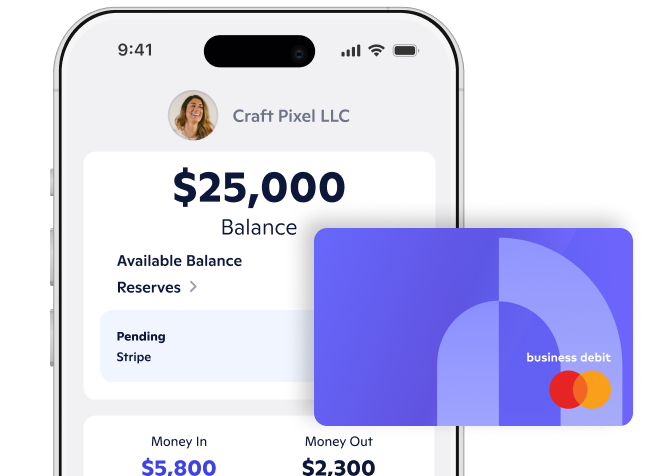
Many new businesses start as a sole proprietorship — a one-person operation that reflects the name of its owner. Although this kind of entity is the simplest possible formation for a startup, you'll want to think about how your small business is legally structured as it grows. The type of business entity you choose has implications for your taxes, liability, and appeal to lenders. You may reach a point at which it makes sense to change your business entity from a sole proprietorship to an LLC. To help your business succeed, it's important to understand why, when, and how to make that change.
What is a sole proprietorship?
A sole proprietorship is an unincorporated business owned and operated by one individual, the sole proprietor. In this structure, you — the owner — are your business. This means that you're entitled to all its profits, but you're also liable for any debts, losses, and obligations — including any liabilities caused by anyone who works for you. For example, if you're sued, the courts could use your personal assets — such as your home, car, and savings — to help cover the costs associated with your liability.
Pros of sole proprietorship
- Credit and banking: You can use your established personal credit lines and personal bank account.
- Simple operating structure: As the sole owner of your business, you have complete control and maximum flexibility. There’s no need to get input from a third party.
- Less paperwork and easier taxes: With a sole proprietorship, you'll have fewer compliance requirements, and you won't have to file a separate tax return for your business. You'll account for profits, losses, and write-offs in your personal tax documents.
- Fewer fees: With other business structures, such as an LLC, you'll have to keep your state registration up-to-date, and you'll pay the associated fees. Sole proprietorships are often exempt from this process, saving you money.
Cons of sole proprietorship
- No liability protection: You're personally liable for all business debts, responsibilities, and losses. Creditors can go after your personal assets to satisfy a claim if your business assets are insufficient.
- No tax flexibility: A sole proprietorship will mean that you'll pay taxes at your personal rate. You'll also have to pay self-employment taxes.
- More difficulty securing funds: Banks tend to associate sole proprietorships with higher turnover rates and fewer assets. Banks consider loans extended to these entities to be personal loans, which could affect your personal credit score.
What is an LLC?
An LLC is a business structure governed by state statute that grants LLC owners personal liability protection so that they aren't responsible for the business's debts or other liabilities. One person can own an LLC, which is called a single-member LLC, or multiple people can have ownership stakes, which is called a multi-member LLC.
Pros of an LLC
- Liability protection: Running your business as an LLC limits your level of personal liability in the event of legal issues or business debt.
- Structural flexibility: You can form an LLC as a single member, but you also can have an unlimited number of members.
- Tax flexibility: Taxing authorities will tax LLCs as a sole proprietorship, partnership, S corporation, or C corporation. You can choose how you want your LLC to be taxed, which can save you money.
- Loan access: An LLC is viewed as its own separate entity, so it may be easier to find loans compared to a sole proprietorship.
Cons of an LLC
- Structural complexity: Ownership of an LLC is shared by its members unless it's a single-member LLC. You may need an operating agreement to define each member's ownership share, voting rights, and profit share.
- Trickier tax filings: Depending on your LLC's federal tax status, an LLC must have its own tax return, and many states can charge an LLC a franchise or capital values tax.
- State registration and renewal fees. You will register your LLC in the state it's located in, which involves fees. You may also have to pay annual or biannual fees, depending on the state.
Differences between a sole proprietorship and an LLC
There are three key differences between a sole proprietorship and an LLC: how you file taxes, the number of owners the business can have, and the availability of liability protection. With a sole proprietorship, the business has one member; that person can use their own lines of credit for the business and include business profits and losses on their tax return. But as we’ve noted, they're also personally liable for the business's obligations, debts, and liabilities. An LLC can have multiple members. It also protects owners from personal liability. Depending on how the IRS will treat a specific LLC, the business might need to file its own tax return.
Reasons for converting a sole proprietorship to an LLC
If your business is growing, it's likely developing new needs and becoming vulnerable to new liabilities. When you reach a point where those liabilities are bigger than anything you’d be willing or able to face as an individual, then it’s likely time to start thinking about restructuring into an LLC. You may also reach a point where you want more heads at the executive table to bring new thought leadership to your business and share the responsibilities associated with entrepreneurship. An LLC will be helpful in that situation because it lets you add members who can bring their experiences to the mix and potentially invest in the business as well.
How to switch from a sole proprietorship to an LLC
Making the transition from a sole proprietorship to an LLC won't happen overnight, but in the long run, it can be incredibly beneficial for your business. Here's how to change a sole proprietorship to an LLC.
Meet eligibility requirements
If you are unsure about exactly how to change your business entity from a sole proprietorship to an LLC, do your research online or look for legal advice. While this may cost money upfront, it can ensure the transition is efficient and follows all the applicable laws.
Choose a name for your LLC
Before you form your LLC, you'll need to find out if the business name you want to use is available and doesn't infringe on any trademarks. Many states let you check if a name is available through the Secretary of State's website. If the name is available, you can file by paying a filing fee and submitting the required documents. You also must dissolve the original sole proprietorship by notifying the IRS and state tax authorities.
Select your LLC's registered agent
A registered agent is the LLC's point of contact for communicating with legal authorities, such as receiving and executing legal documents. You can function as the registered agent or assign the role to an attorney.
File articles of organization
When forming an LLC, a crucial step is filing its articles of organization. These include detailed information about your business, such as your business name, registered agent and address, names of members, address of the principal place of business, and authorized signatures. Some, but not all, states require a statement of purpose and the duration of time that your LLC will operate.
Obtain an EIN
Filing for a new employer identification number (EIN) will be your next step in the transition. You will use the EIN for filing business taxes, opening a business bank account, facilitating payroll, and receiving credit for your company.
Register with the IRS
Based on elections made by the LLC and the number of members, the IRS will treat an LLC as a corporation, partnership, or as part of the LLC's owner's tax return (a disregarded entity). The IRS will classify a domestic LLC with at least two members as a partnership for federal income tax purposes. The IRS will treat the LLC as a corporation if it elects to file Form 8832. For income tax purposes, the IRS will treat an LLC with only one member as an entity disregarded as separate from its owner. Again, the LLC can choose to file Form 8832 to be treated as a corporation. However, for purposes of employment tax and certain excise taxes, an LLC with only one member is still considered a separate entity.
Apply for business licenses
When you make the switch from a sole proprietorship to an LLC, you will have to reapply for any licenses or permits legally required for you to run your business. These vary based on industry and state regulations, but some examples include a professional license, health department permit, or reseller permit.
Draft an LLC operating agreement
One of the things that will help you more effectively manage your LLC is to put written guidance in place by creating an operating agreement. The operating agreement is a legally binding document that typically includes the percentage of ownership for each member, voting privileges and obligations, rights and day-to-day responsibilities, profit and loss sharing, the process for meetings, and buyout protocols. Most importantly, operating agreements help you establish personal liability protection for yourself and other members. Companies that don't have operating agreements are subject to their state's default rules.
Apply for a business bank account and inform clients
If you don't yet have a business banking account, it's vital to separate your business funds from your personal funds, particularly as the owner of an LLC. In fact, the right banking partner for your business can be a key factor in its continued growth and success. From features that speed up your cash flow or provide better visibility into your business finances to integrations with top business software, you'll want to choose a business banking platform that simplifies and streamlines how you manage your business finances. Learn why Novo facilitates one of the best business checking accounts for LLCs and apply for an account today.
If you already have a business checking account, you may have to close the account associated with your sole proprietorship after all existing business associated with the account is finalized. On the other hand, if you are a Novo account holder, we make the transition smooth. We will help you update the EIN associated with your account, as well as your business name and type, as soon as you convert your business from a sole proprietorship to an LLC.
Contact your insurance provider
You will also need to contact your insurance provider to inform them of your business entity change. Depending on your circumstances, you may need to adjust your existing insurance policy or buy a different policy altogether.
Update your marketing materials
Updating your remaining credentials is the last step of making the transition from a sole proprietorship to an LLC. If you've changed your business name, you may need to change your business letterhead, website, social media, business cards, and various other marketing materials or relevant contact information.
Takeaways
As a small business owner, it can be overwhelming to take risks and make changes, but there are countless tools and resources available to help you decide if your business should transition from a sole proprietorship to an LLC. Making the switch from a sole proprietorship to an LLC may be the next step you should take to set your business up for growth and long-term success. Novo can help you navigate the road ahead, no matter where you are in your entrepreneurial journey.
Novo is a fintech, not a bank. Deposit account services provided by Middlesex Federal Savings, F. A.; Member FDIC.
Novo Platform Inc. strives to provide accurate information but cannot guarantee that this content is correct, complete, or up to date. This page is for informational purposes only and is not financial or legal advice nor an endorsement of any third-party products or services. All products and services are presented without warranty. Novo Platform Inc. does not provide any financial or legal advice, and you should consult your own financial, legal, or tax advisors.
%201.png)
.png)




